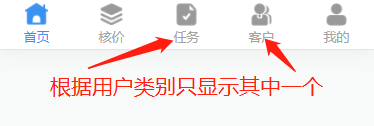项目场景:
要求:根据用户登录的账号权限,底部tabBar显示不同的入口。

解决方案一:
提示:该方案需要Hbuilder是3.2.10+。这个版本以上在tabBar的list数组对象可以有visible属性用来控制显示和隐藏。
// page.json文件
"tabBar": {
"color": "#7A7E83",
"selectedColor": "#3992f0",
"borderStyle": "black",
"backgroundColor": "#ffffff",
"list": [......, {
"pagePath": "pages/tabbar/client",
"iconPath": "static/images/kehu.png",
"selectedIconPath": "static/images/select_kehu.png",
"text": "客户",
"visible":false
}, ......]
}
明白了这个属性,那么我们就可以通过uni.setTabBarItem(OBJECT)方法去操作tabBar来实现我们想要的效果,这个方法在App.vue调用一次所有的页面都会生效。
// 需要处理的文件
onShow() {
if('你判断的方式'){
uni.setTabBarItem({
index: 2, // tabBar 的哪一项,从左边算起
visible:true // 该项是否显示
})
// 状态切换的时候把刚才显示的给主动隐藏了,不然会一直显示
uni.setTabBarItem({
index: 3,
visible:false
})
}else{
uni.setTabBarItem({
index: 2,
visible:false
})
uni.setTabBarItem({
index: 3,
visible:true
})
}
},
解决方案二:
写一个tabBar组件,在Hbuilder版本3.2.10之前都是这样实现的,话不多说上代码。tabbar.vue组件文件:
<!-- tabbar.vue组件文件 -->
<template>
<view class="tabbar" :style="{'padding-bottom': paddingBottomHeight + 'rpx'}">
<view :class="['tabbar-item',isShow == index? 'is-show' : '']" v-for="(item, index) in list" :key="index" @click="tabbarChange(item.path)">
<image class="item-img" :src="item.icon_a" v-if="current == index"></image>
<image class="item-img" :src="item.icon" v-else></image>
<view class="item-name" :class="{'tabbarActive': current == index}" v-if="item.text">{{item.text}}
</view>
</view>
</view>
</template>
<script>
export default {
props: {
current: Number,
isShow: Number
},
data() {
return {
paddingBottomHeight: 0, //苹果X以上手机底部适配高度
list: [{
text: '首页',
icon: '/static/images/home.png', //未选中图标
icon_a: '/static/images/select_home.png', //选中图片
path: "/pages/tabbar/index/index", //页面路径
}, {
text: '核价',
icon: '/static/images/hejia.png',
icon_a: '/static/images/select_hejia.png',
path: "/pages/tabbar/dynamic/dynamic",
}, {
text: '任务',
icon: '/static/images/task.png',
icon_a: '/static/images/select_task.png',
path: '/pages/tabbar/question/question',
}, {
text: '客户',
icon: '/static/images/kehu.png',
icon_a: '/static/images/select_kehu.png',
path: "/pages/tabbar/client/client",
}, {
text: '我的',
icon: '/static/images/me.png',
icon_a: '/static/images/select_me.png',
path: "/pages/tabbar/mine/mine",
}, ]
};
},
created() {
let that = this;
uni.getSystemInfo({
success: function(res) {
let model = ['X', 'XR', 'XS', '11', '12', '13', '14', '15'];
model.forEach(item => {
//适配iphoneX以上的底部,给tabbar一定高度的padding-bottom
if (res.model.indexOf(item) != -1 && res.model.indexOf('iPhone') != -1) {
that.paddingBottomHeight = 40;
}
})
}
});
},
methods: {
tabbarChange(path) {
uni.switchTab({
url: path
})
}
}
};
</script>
<style lang="scss" scoped>
.tabbarActive {
color: #3992F0 !important;
}
.tabbar {
position: fixed;
bottom: 0;
left: 0;
right: 0;
display: flex;
justify-content: space-around;
align-items: center;
width: 100%;
height: 100rpx;
background-color: #ffffff;
.tabbar-item {
display: flex;
flex-direction: column;
align-items: center;
justify-content: center;
height: 100rpx;
.item-img {
margin-bottom: 4rpx;
width: 46rpx;
height: 46rpx;
}
.item-name {
font-size: 26rpx;
color: #A3A3A3;
}
}
}
.is-show{
display: none !important;
}
</style>
组件写好,然后再在page.json文件中写好底部的tabbar(如果没有配置需要把页面跳转的方法改成清空当前所有页的跳转)建议配置,这样页面效果会好一点。最后在需要的页面进行引入组件
<template>
<view>
......
<!-- :current的值在那个页面用那个值 -->
<tabbar :current="0" :isShow="isShow"></tabbar>
.....
</view>
</template>
<script>
import Tabbar from "@/components/tabbar.vue";
export default {
components: {
Tabbar
},
onShow() {
uni.hideTabBar({
animation: false
})
},
data() {
return {
isShow:3,//进行处理来控制那个tabbar隐藏,
}
},
}
</script>
总结:
Ctrl+C Ctrl+V 梭哈
























 4720
4720











 被折叠的 条评论
为什么被折叠?
被折叠的 条评论
为什么被折叠?










